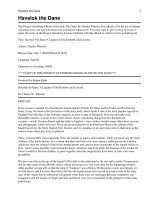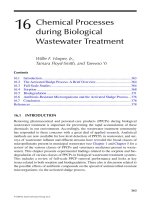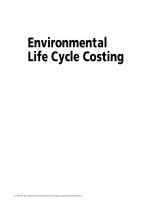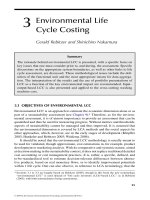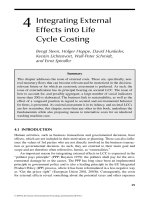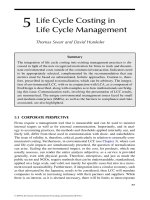Product Design for the Environment: A Life Cycle Approach - Chapter 16 (end) docx
Bạn đang xem bản rút gọn của tài liệu. Xem và tải ngay bản đầy đủ của tài liệu tại đây (461.28 KB, 19 trang )
435
Chapter 16
Methodological Framework and Analysis
Models for Simulation of the Product
Life Cycle
Product analysis undertaken from the perspective of Life Cycle Design
requires the defi nition of procedures and tools to steer the designer towards
the best choices in relation to the product’s performance—conventional and
environmental—over its whole life cycle. Design choices can be directly
linked to product performance using models of product behavior. With these
models it is possible to simulate the life cycle in relation to phenomena of
deterioration in performance of materials (due to external factors or loading
conditions).
This chapter presents a methodological framework and the models for
such analysis to allow the simulation of product life cycle at the design stage.
The case study reported shows how the simulation method, complemented
by analytical tools, can be applied to associate each set of design choices
under examination with a broad spectrum of information: the durability
and criticality of components and the system, as a function of the period of
use; possible faults and the consequent servicing costs; the residual life of
components, their possible reuse at the end-of-life, and consequent exten-
sion of the system’s useful life; and the environmental impact of the whole
product life cycle.
The fundamental issues in this chapter were previously introduced in
16.1 Simulation and the Life Cycle Approach
Life Cycle Design consists of a design intervention that incorporates all the
phases of the product’s life cycle (development, production, use, maintenance
and repair, retirement, recovery) in the entire design process, from the phase
2722_C016_r02.indd 4352722_C016_r02.indd 435 11/30/2005 1:53:10 PM11/30/2005 1:53:10 PM
© 2006 by Taylor & Francis Group, LLC
Chapters 3, 9, 10, and 15.
Section 3.1.1). The traditional evolutionary approach is based on the feedback
of information fl ows used to improve the design intervention; a powerful
alternative can consist of already predicting the consequences of design
choices on the product’s life cycle during the solution synthesis phase itself.
This is equivalent to simulating the life cycle of the product in the early phases
Therefore, it could be extremely helpful to defi ne a methodological frame-
work and relative analytical tools in support of the design process, allowing
the management of design choices (both at the level of product layout and
that of the specifi cations of components), in relation to the product’s conven-
tional (functionality, reliability, cost) and environmental performance over its
life. When variations in the design choices are proposed, such as reorganiza-
tion of the architecture or modifi cation of component geometries and materi-
als, these tools must allow the simulation of the resulting life cycle so that it
is possible to compare the various alternatives and identify the solutions that
best realize appropriate performance goals. With particular regard to the
simulation of the fi nal phases of the life cycle (i.e., use and retirement), the
objective performances to be optimized must be related not only to the design
choices but also to factors of deterioration that can alter the behavior of the
16.2 Approach to the Problem and Methodological Framework
With these aims, this chapter proposes a method of simulating product
behavior over its life cycle and the relative analytical tools to obtain, for every
possible set of design choices:
• Indications of the duration, safety, and criticality of single compo-
nents and of the overall system, on varying the time of use
• Indications of possible failures and evaluations of the resulting
servicing costs
• Indications of the residual life of components, evaluation of their
possible reuse, and quantifi cation of the resulting potential exten-
sion of the system’s useful life
• Evaluation of the environmental impact associated with the main
phases of the life cycle
The main diffi culty consists of correlating design parameters with product
performance in its life cycle after production. This requires not only a model-
ing of the life cycle, but also an appropriate modeling of the product as a
basis for simulating its behavior in response to different design choices.
436 Product Design for the Environment
2722_C016_r02.indd 4362722_C016_r02.indd 436 11/30/2005 1:53:11 PM11/30/2005 1:53:11 PM
© 2006 by Taylor & Francis Group, LLC
of concept defi nition to that of detailed design development (Chapter 3,
product and its components over time (Chapter 10).
of the design process (Chapter 3, Section 3.2.4).
Methodological Framework and Analysis Models 437
The importance of life cycle modeling in the process of product develop-
ment, in relation to the environmental impact, has already been demon-
strated (Zust and Caduff, 1997). Also, some approaches to life cycle
simulation have been outlined with particular reference to modular prod-
ucts (Tomiyama et al., 1997) and in more general terms (Kato et al., 2001); see
cycle models according to elementary activities that aid the inventory phase
of Life Cycle Assessment, in accordance with the indications of ISO14040
standards. The second proposes simulation schemes that provide particular
information on the product’s environmental impact (quantifying the fl ow of
materials discharged or translating the impact of end-of-life into economic
terms) without detailing the correlation with the main design parameters.
Furthermore, while introducing the temporal variable governing the simu-
lation, these schemes rarely study in depth this concept in relation to the
phenomena of performance decay and to the consequent effect on the
system’s effi ciency (Hata et al., 1997).
As summarized in the scheme in Figure 16.1, the development of the
method proposed here makes use of certain tools opportunely correlated
with indices expressing the decay of performance over time:
• A model of the constructional system, based on the behavior of
functional subgroups
FIGURE 16.1 Methodological framework and tools.
2722_C016_r02.indd 4372722_C016_r02.indd 437 11/30/2005 1:53:11 PM11/30/2005 1:53:11 PM
© 2006 by Taylor & Francis Group, LLC
also Chapter 3, Section 3.2.4. The fi rst deals with approaches defi ning life
• Certain signifi cant functions that express the system’s performance
in relation to the possible strategies of improving the life cycle under
examination, which are the optimization of the useful life (through
servicing operations on the system) and the recovery of resources at
end-of-life (through the reuse and recycling of components)
With the support of these tools it is possible to outline a simulation proce-
dure allowing the evaluation, already in the design phase, of the product’s
possible behavior in the intermediate and fi nal phases of the life cycle (use
and end-of-life), according to the main design choices and the duration of
use. This behavior must be evaluated using objective functions that are rele-
vant to the aims of optimal product design. They must quantify the behavior
of the product in relation to three main aspects:
• Level of functional effi ciency and safety of the constructional
system
• Costs of the product in relation to the main phases of the life cycle
• Environmental impact of the whole life cycle and the recovery poten-
tial of the resources used
16.3 Product Model and Analysis Tools
Again r
ered in more detail. To correlate the set of design choices and product perfor-
mance, the methodological approach proposed here is based on advanced
Failure Mode and Effect Analysis (FMEA), scheduling the development of a
product behavior model based on its function rather than on its structure
(Eubanks et al., 1996; Eubanks et al., 1997). This is based on the defi nition of
the main elementary functionalities of the constructional system, on the set
of determining variables required for the behavior under examination to take
place (initial state) and fi nal conditions reached after the function has taken
place (fi nal state), and of the performance characteristics regulating the
behavior, which can generally be expressed using mathematical models.
With regard to the evaluation of variations in the system’s performance
over time, in the method proposed here this can be calculated in relation to
different typologies of decay phenomena:
• Independent from load conditions (e.g., aging of the materials)
• Dependent on the load conditions (e.g., fatigue)
Taking into consideration a defi ned set of materials characterized by decay
curves, it is possible to evaluate the indices that provide information on the
438 Product Design for the Environment
2722_C016_r02.indd 4382722_C016_r02.indd 438 11/30/2005 1:53:12 PM11/30/2005 1:53:12 PM
© 2006 by Taylor & Francis Group, LLC
eferring to the scheme in Figure 16.1, the main points can be consid-
Methodological Framework and Analysis Models 439
duration of components (Index of Duration—DI) and on safety (Dynamic
Criticality Factor —DCF) over the life cycle. On these bases, the simulation of
the system’s functionalities allows the identifi cation of possible failures and
their classifi cation in terms of their effect on components. It is then possible
to derive the criticality of the system through analysis of the confi guration of
the model (blocks in a series or parallel), the danger of a failure, and the
residual performance level.
This information directly infl uences possible strategies for improving
the environmental performance of the life cycle considered here and also
operations on the system) and the recovery of resources at end-of-life
(through the reuse and recycling of components). In this regard, reference
is made to the calculation models already available for both the evaluation
of the economic impact of servicing systems during their useful life
(Gershenson and Ishii, 1993) and for the planning of recovery cycles at
respectively, the Life Cycle Service Cost (LCSC) and the Extension of
Useful Life (EUL).
16.3.1 Model of System Behavior
As mentioned above, design choices and product performance are correlated
using a model of the system’s behavior based on advanced FMEA (Eubanks
et al., 1996; Eubanks et al., 1997). This model defi nes the main elementary
functionalities of the constructional system, the determining variables
required for the behavior under examination to take place, the fi nal state
after the function has taken place, and the performance conditions regulating
main functionality, broken down into elementary behaviors in series and in
parallel. BHV
s
is the s-th behavior in series; if it is constituted by np
s
behavior
in parallel, BHV
sp
is the p-th behavior in parallel constituting the s-th behav-
ior in series. Each elementary behavior is defi ned by:
• Components directly involved in the behavior; n
s
is the number of
components involved in the s-th behavior
• Mathematical models expressing the performance conditions that
regulate the behaviors; nv
s
is the total number of performance condi-
tions for s-th behavior, generally consisting of functions linking
performance conditions Pf
v
to operating conditions, to fi xed and
variable geometric parameters, and to the properties of the materials
(preconditions)
• Performance limits Pf*
v
, which, compared with Pf
v
, make it possible to
establish whether the behavior takes place correctly (postconditions)
2722_C016_r02.indd 4392722_C016_r02.indd 439 11/30/2005 1:53:12 PM11/30/2005 1:53:12 PM
© 2006 by Taylor & Francis Group, LLC
discussed in Chapter 9: optimization of the useful life (through servicing
end-of-life (Chapter 15). The indicators proposed by these models are,
the behavior. Figure 16.2 shows the reference scheme for a system based on a
440 Product Design for the Environment
16.3.2 Evaluation of Performance Decay
Simulating the system’s behavior requires an evaluation of the variations in its
behavior over time. While distinguishing between the two different typologies
of decay phenomena (independent from and dependent on load conditions), it
is generally possible to ascribe the phenomena to material performance diagrams
of the fi rst type, and the real time of use for phenomena of the second type.
Once the materials comprising the system have been chosen and each is
characterized by its corresponding decay curve, it is possible to evaluate the
indices providing information on the duration of the components and on the
level of safety over the time of use, and thus over the life cycle.
16.3.2.1 Duration Index
With regard to the fi rst aspect, an index of the duration of the component (DI)
is introduced. This is defi ned as the ratio between the estimated physical life
of the component t
r
, determined by the performance required Pf
r
, and the
fi xed useful life t
u
, which is a design requisite:
DI =
t
t
r
u
(16.1)
FIGURE 16.2 Model of system behavior: Reference scheme.
2722_C016_r02.indd 4402722_C016_r02.indd 440 11/30/2005 1:53:12 PM11/30/2005 1:53:12 PM
© 2006 by Taylor & Francis Group, LLC
(Figure 16.3) where the time variable t represents real time for the phenomena
Methodological Framework and Analysis Models 441
Having fi xed the duration of the useful life t
u
, this index DI depends on t
r
(i.e.,
both of the material, since the decay curve varies with this, and of the compo-
nent geometry, which determines the working conditions and therefore the
required performance Pf
r
). The value of DI provides indications of the compo-
nent’s operating conditions over the arc of its useful life and allows the quan-
tifi cation of both the need for servicing operations and the possibility of reusing
the component. In the case where DI < 1, the need to substitute the component
f times over the entire arc of the useful life can be anticipated with:
f = int
DI
1
⎛
⎝
⎜
⎞
⎠
⎟
(16.2)
If 1 < DI < 2, the component can be used only once. In the case where DI > 2,
the component can be reused r times, with:
r = int DI
(
)
−1
(16.3)
16.3.2.2 Dynamic Criticality Factor
Considering the variation in a component’s level of safety over time, and again
.
DCF
Pf Pf
Pf Pf
0
0r
ϭ
Ϫ
Ϫ
(16.4)
where Pf
0
is the component’s initial performance, Pf is that corresponding to
the generic time t, and Pf
r
is again the required performance. This index
FIGURE 16.3 Decay of performance: Reference diagram.
2722_C016_r02.indd 4412722_C016_r02.indd 441 11/30/2005 1:53:12 PM11/30/2005 1:53:12 PM
© 2006 by Taylor & Francis Group, LLC
referring to Figure 16.3, the Dynamic Criticality Factor (DCF) is introduced:
442 Product Design for the Environment
quantifi es the increase in the component’s criticality during its use, and for
t = t
u
expresses the criticality corresponding to the end of use (in this case, the
notation DCFu will be used).
If Pf
u
indicates the performance level corresponding to the end of useful
life, it is seen that:
• If Pf
u
> Pf
r
then DCFu < 1; therefore, the component is not critical.
• If Pf
u
< Pf
r
then DCFu > 1; therefore, the component is critical and is
the more critical the higher the value assumed by DCFu.
16.3.2.3 Behavior Criticality Index
As above, according to the system model introduced here, each of the system’s
behaviors is determined by a set of components. Indicating the generic
component correlated to the behavior with C
i
, and the corresponding value
of the dynamic criticality factor at end of use with DCFu
i
, the Behavior
Criticality Index (BCI) is defi ned as:
BCI c max DCFu
i
ϭ ⋅
()
(16.5)
where c ⑀ [0,1] is an additional factor expressing the criticality of the behavior
under examination in relation to the functionality of the whole system. If a
“nonbehavior” results in the total arrest of the system, this must be classifi ed
with a high c factor, given the importance of the failure. The higher the value
of BCI, the more critical the behavior under examination, both for the effect
of its failure on the system and for the decrease in performance level, quanti-
fi ed by the dynamic criticality factor. The distribution of the values assumed
by BCI for each behavior on varying the design parameters allows an analy-
sis of the criticality of the system under examination.
16.3.3 Analysis of Life Cycle Strategies
The values assumed by the indices of performance decay introduced above
directly condition the possible strategies for improving the environmental
behavior of the life cycle (i.e., the strategies for improvement of resource
the useful life (through servicing operations) and recovery of resources at
end-of-life (through component reuse and recycling). The following mathe-
matical reference models can be used to quantify these behaviors.
16.3.3.1 Life Cycle Service Cost
The strategies for optimizing the useful life of products include interventions
of diagnosis, maintenance, repair, substitution, and any other operations that
2722_C016_r02.indd 4422722_C016_r02.indd 442 11/30/2005 1:53:13 PM11/30/2005 1:53:13 PM
© 2006 by Taylor & Francis Group, LLC
exploitation, as were introduced in Chapter 9). These include optimization of
Methodological Framework and Analysis Models 443
Section 9.2). For an evaluation of the effect that design choices can have in
terms of ease of servicing, mathematical models that express the life cycle
service costs can be used (Gershenson and Ishii, 1993). Given a component
requiring several service operations, the cost of the w-th service operation on
the i-th generic component is given by:
Cs tl cl c
iw iw iw i
ϭϩ⋅
(16.6)
where tl
iw
is the time of intervention, cl
iw
is the cost of the intervention per
unit time, and c
i
is the cost of the component or of the material required in the
intervention.
Considering as service interventions the substitution of failed components,
for a system consisting of n components C
i
, the total Life Cycle Service Cost
(LCSC) is expressed by:
LCSC Cs
iw
w = 1
f
i = 1
n
i
ϭ
∑∑
(16.7)
where f
i
is the number of substitution interventions required for the i-th
component, defi ned by Equation (16.2).
16.3.3.2 Recovery Cycles and Extension of Useful Life
The problem of planning recovery cycles in relation to the duration of the
components has already been treated by the authors (Giudice et al., 2003), and
model was proposed that takes account of the environmental impact of produc-
ing the i-th component, EI
Prod i
. This can be expressed in terms of the eco-indica-
tors of the materials and processes, defi ned by Equation (15.9) of Chapter 15:
EI = ei W ei
Prod Mat i Pr i
k=1
h
pr i
ii k
i
k
⋅⋅
∑
ϩ
(16.8)
Considering that it is possible to anticipate a number of recovery cycles m,
the recovery fraction that can be associated with the j-th cycle (in terms of
environmental impact) can be expressed by Equation (15.10) of Chapter 15:
⌽
j
EI
ij
i = 1
n
Prod
Prod
i = 1
n
=
r EI
EI
i
i
∑
∑
⋅
(16.9)
2722_C016_r02.indd 4432722_C016_r02.indd 443 11/30/2005 1:53:13 PM11/30/2005 1:53:13 PM
© 2006 by Taylor & Francis Group, LLC
may be necessary to ensure the correct functioning of the system (Chapter 9,
some signifi cant results have been reported in Chapter 15, where a calculation
444 Product Design for the Environment
where r
ij
is a binary coeffi cient that assumes unitary value only in the case
where the i-th component is reusable at the j-th cycle. This is, therefore, easily
expressed as a function of r, the number of possible component reuses, given
by Equation (16.3).
Hypothesizing a constant duration of all the reuses, equal to the fi xed dura-
tion of the fi rst use t
u
, the function quantifying the extension of useful life is
EUL = t
j = 1
m
u
Φ
k
EI
k
j
=
∏∑
⎡
⎣
⎢
⎤
⎦
⎥
⋅
1
(16.10)
This function, which expresses the extension of the life of original compo-
nents within the life cycle of the product, can be considered an indicator of
savings in resources according to their different environmental impacts.
16.4 Defi nition of Objective Functions
As above, the product’s behavior in the life cycle must be evaluated in rela-
tion to its functional capacities, to the economic costs, and to the environ-
mental performance. With this aim, and with reference to the mathematical
models proposed so far, the following objective functions are proposed:
• The criticality index of the constructional system, identifi ed in the
mean or maximum values assumed by the BCI indices expressing,
through Equation (16.5), the criticality of each behavior of the
system
• The product’s costs over the life cycle, which, ignoring the costs of
product retirement, can be quantifi ed by the production and servic-
ing costs, the latter expressed by LCSC defi ned in function (16.7)
• The potential extension of useful life of the resources used in the
system through the recovery of components, expressed by EUL
defi ned in function (16.10)
• The environmental impact of the life cycle, quantifi ed by the sum of
the impacts associated with the phases of production, use (servic-
ing), and retirement
The last function requires further development of the mathematical models,
as discussed below.
These objective functions evaluated for each design choice are suit-
able for treatment using multiobjective analysis, with the ultimate aim of
2722_C016_r02.indd 4442722_C016_r02.indd 444 11/30/2005 1:53:13 PM11/30/2005 1:53:13 PM
© 2006 by Taylor & Francis Group, LLC
defi ned as (see Chapter 15, Section 15.3.6):
Methodological Framework and Analysis Models 445
determining which solution best satisfi es the entire spectrum of desired
performances.
16.4.1 Environmental Impact of the Life Cycle
The function expressing the environmental impact of the life cycle EI
LC
is
the sum of three terms, each relative to the main phases of the cycle: produc-
tion, use (servicing), and end-of-life.
.
EI EI EI EI
LC Prod Srv EoL
ϭϩϩ
(16.11)
The fi rst term can be expressed as the sum of the environmental impacts
associated with the production of the individual components EI
Prod i
[Equation
(16.8)]:
EI ei W ei
Prod Mat i Pr i
k = 1
h
pr i
i = 1
n
ik
i
k
ϭϩ⋅⋅
⎛
⎝
⎜
⎞
⎠
⎟
∑∑
(16.12)
The environmental impact of use, assimilable to the impact associated with
service operations, can be defi ned on the basis of the servicing costs model
LCSC [Equation (16.7)], considering that every substitution of a failed compo-
nent corresponds to an environmental impact equal to that of the component’s
production.
EI f ei W ei
Srv i
i = 1
n
Mat i Pr i
k = 1
h
pr i
ik
i
k
ϭϩ⋅⋅ ⋅
⎛
⎝
⎜
⎞
⎠
⎟
∑∑
(16.13)
The last term of Equation (16.11), relating to the product’s end-of-life, is
composed of three terms depending on whether the components are
discarded or recovered through reuse or recycling:
EI EI EI EI
EoL Dsp Rcl Rs
ϭϩϩ
(16.14)
With reference to the parameter of reuse r expressed by Equation (16.3), an
additional binary coeffi cient is introduced. This assumes unitary value only
in the case where r у1; otherwise it is 0.
Incorporating this in the defi nition of the fi rst term of Equation (16.14), it
can be expressed as follows:
EI EI ei W f
Dsp Dsp
i = 1
n
Dsp
i = 1
n
ii i i
ii
ϭϭ ϩϪϪ
∑∑
⋅⋅
(
)
⋅
(
)
⋅
(
)
11 1
(16.15)
2722_C016_r02.indd 4452722_C016_r02.indd 445 11/30/2005 1:53:13 PM11/30/2005 1:53:13 PM
© 2006 by Taylor & Francis Group, LLC
similar to those previously introduced in Chapters 12 and 14. It is defi ned as
446 Product Design for the Environment
where ei
Dsp i
is the environmental impact of disposal per unit weight, W
i
is the
weight of the component,
i
is the recyclable fraction of the material forming
the component, and f
i
is the number of required substitutions during use,
expressed by Equation (16.2). Analogously:
EI EI ei W f
Rc1 Rc1
i = 1
n
Rc1
i = 1
n
iii i
ii
ϭϭ ϩϪ
∑∑
⋅⋅
()
⋅
()
⋅
()
11
(16.16)
where ei
Rcl i
is the environmental impact of the recycling process per unit
weight and the other terms are as defi ned above.
Equations (16.15) and (16.16) are not 0 only for components that cannot be
reused (
i
= 0).
The last term of Equation (16.14) refers to the environmental impact at the
end-of-life, due only to reusable components (
i
= 1), and is expressed by:
EI EI EI
Rs Rs
i 1
n
Prod
i 1
n
ii
ii
ϭϭϪ
ϭϭ
∑∑
()
⋅⋅r
(16.17)
where again EI
Prod i
is expressed by Equation (16.8) and r
i
by Equation (16.3).
This term thus expresses a recovery of environmental impact, as the sum of
production impacts associated with reusable components.
As in other previous chapters, all the eco-indicators considered are evalu-
16.5 Simulation and Analysis of Results
This simulation procedure follows the development of the models proposed
design parameters that constitute the variables to be optimized, and the
objective functions (Section 16.4) that quantify the product’s performance in
the main phases of the life cycle. This relation is structured using the behav-
ior model of the system (Section 16.3.1) and is expressed analytically, using
the indicators of component duration and failure derived from the deteriora-
tion of performance over time (Section 16.3.2).
To illustrate the application of the methodology, the results obtained on a
rized below.
16.5.1 Behavior Model of the System
From an analysis of the gear box’s operation it is possible to defi ne the system
model which, in this case, is very simple and can be reduced to elementary
2722_C016_r02.indd 4462722_C016_r02.indd 446 11/30/2005 1:53:13 PM11/30/2005 1:53:13 PM
© 2006 by Taylor & Francis Group, LLC
and is summarized in Figure 16.1. It is based on a direct relation between the
mechanical system, the four-speed gear box shown in Figure 16.4, are summa-
ated according to the Eco-indicator 99 method (Chapter 4, Table 4.3).
Methodological Framework and Analysis Models 447
behaviors, largely in a series. Only one behavior, that representing the trans-
mission of torque according to the gear engaged, breaks down into four
subbehaviors in parallel, corresponding to each gear.
the information associated with behavior 1.1 (transmission of the torque
from the motor shaft to the clutch): the components involved, the mathemat-
ical models expressing the required performance (in this case the structural
strength), and the verifi cation of the fi nal state of the behavior.
16.5.2 Performance Evaluations and Analysis of Criticality
Having developed the behavior model, the analysis continues with the simu-
lation of the functional performance of individual components over the life
cycle of the system. On the basis of the design requirements (summarized in
Figure 16.4), by varying the design choices (in particular materials and
geometric parameters) it is possible to determine the loading conditions of
each component and its required duration. In this regard it is necessary to
consider certain details. The components comprising the system are subjected
to fatigue loading. The gear box is destined for a motor vehicle; if the number
of kilometers the vehicle is expected to travel is set as a design datum (vehicle
mission), it is possible to determine the number of loading cycles of each
component. Thus, all the time variables t introduced above (Section 16.3.2) are
to be understood as loading cycles, and the decay of performance is expressed
FIGURE 16.4 Case study: Gear box.
2722_C016_r02.indd 4472722_C016_r02.indd 447 11/30/2005 1:53:14 PM11/30/2005 1:53:14 PM
© 2006 by Taylor & Francis Group, LLC
by the resistance to fatigue curves of the materials (Chapter 10, Section 10.2).
The scheme of the model is partially represented in Figure 16.5, presenting
448 Product Design for the Environment
by the choice of materials and the specifi cation of geometric parameters.
For each component, the table gives the chosen material; the number of
expected loading cycles t
u
related to the fi xed mission; the required perfor-
mance level Pf
r
(mechanical strength in MPa); and the number of loading
cycles t
r
guaranteed by the chosen material, in relation to Pf
r
(t
r
assumes a
value of infi nity when Pf
r
is below the fatigue limit of the material).
The same table then shows the corresponding values assumed by the indica-
tors introduced in Section 16.3.2. In particular, when the duration index DI
[Equation (16.1)] assumes a value of infi nity, r assumes 2 as the conventional
maximum number of possible reuses. Moreover, given that in this fi rst design
alternative the primary shaft is considered a single piece with the correspond-
ing four gear wheels, all fi ve components assume a value of the number of
expected substitutions f equal to the maximum value assumed by each single
component (reported in brackets), and a value of r equal to the minimum.
On the basis of the values assumed by the factor DCFu for each compo-
nent, it is then possible to analyze the distribution of the criticality index of
the behaviors BCI, evaluating their maximum value (indicating the most
critical behavior) and estimating the mean criticality of the entire system
(for design alternative I, mean BCI is equal to 0.80).
16.5.3 First Analysis of the Performance in the Life Cycle
predict the system’s poor performance, both in terms of the use phase
FIGURE 16.5 Case study: Model of system behavior.
2722_C016_r02.indd 4482722_C016_r02.indd 448 11/30/2005 1:53:14 PM11/30/2005 1:53:14 PM
© 2006 by Taylor & Francis Group, LLC
Table 16.1 presents some evaluations for a fi rst design alternative I, defi ned
Again referring to Table 16.1, from the values assumed by f and r, it is possible to
Methodological Framework and Analysis Models 449
TABLE 16.1 Performance evaluation and analysis of criticality: Design alternative I
MATERIAL t
u
Pf
r
(
fc
)
t
r
Dl f r DCFu
Motor Shaft AISI 1015 8,59E+08 49,2 infi nite infi nite 0 2 0,77
Clutch Box AISI 1015 1,72E+08 110,9 infi nite infi nite 0 2 0,91
Motor Gear AISI 1030 8,59E+08 153,5 infi nite infi nite 0 2 0,96
Clutch Spring AISI 1080 3,20E+06 345,1 3,12E+06 0,98
1 0 1,01
Primary Shaft AISI 1015 1,72E+08 115,1 infi nite infi nite (0) 5 (2) 0 0,90
Gear 1 — Primary Shaft AISI 1015 1,72E+08 160,2 3,23E+07 0,19 (5) 5 (0) 0 1,03
Gear 1 — Secondary Shaft AISI 1030 3,54E+07 195,7 1,23E+07 0,35 2 0 1,05
Gear 2 — Primary Shaft AISI 1015 1,72E+08 161,9 3,20E+07 0,19 (5) 5 (0) 0 1,04
Gear 2 — Secondary Shaft AISI 1030 3,54E+07 182,8 3,11E+07 0,88 1 0 1,01
Gear 3 — Primary Shaft AISI 1015 1,72E+08 156,9 6,15E+07 0,36 (2) 5 (0) 0 1,02
Gear 3 — Secondary Shaft AISI 1030 3,54E+07 203,9 5,30E+06 0,15 6 0 1,07
Gear 4 — Primary Shaft AISI 1015 1,72E+08 134,9 infi nite infi nite (0) 5 (2) 0 0,96
Gear 4 — Secondary Shaft AISI 1015 3,54E+07 144,5 1,00E+08 2,83 0 1 0,96
Secondary Shaft AISI 1015 3,54E+07 149,9 1,00E+08 2,83 0 1 0,98
Inner Spring AISI 1080 3,20E+06 363,1 1,07E+06 0,33 2 0 1,04
Mesh Mechanism AISI 1015 8,85E+06 188,6 1,87E+06 0,21 4 0 1,06
2722_C016_r02.indd 4492722_C016_r02.indd 449 11/30/2005 1:53:14 PM11/30/2005 1:53:14 PM
© 2006 by Taylor & Francis Group, LLC
450 Product Design for the Environment
(high number of component failures and substitutions) and the end-of-life phase
(little possibility of component reuse). This is confi rmed by the values assumed
by the functions LCSC and EUL introduced in Section 16.3.3, and evidenced by
comparison with design alternative IIa, which predicts better values for f and r,
and also for the mean BCI (0.78), while production costs remain substantially the
same. This is principally due to a better choice of materials.
The values assumed by LCSC and EUL are further improved in design
alternative IIb. This design differs from IIa only in that the primary shaft and
to be disassembled (this modifi cation does not result in variations in the
behavior model and criticality of the system). In this case, the failure of a
single gear does not require the substitution of the whole shaft–gear unit
(improving LCSC), nor does it limit the possibility of reusing other compo-
nents of the unit (improving EUL). The modifi cation does, however, lead to
an increase in the production cost.
All these r
functions under examination have been normalized (the reciprocal of EUL is
considered to have to minimize all the functions).
16.5.4 Analysis of the Environmental Impact of the Life Cycle
Finally, it is possible to evaluate the environmental impact of the entire life
cycle EI
LC
for the more interesting design alternatives IIa and IIb, using the
FIGURE 16.6 Design alternative IIb: Primary shaft and gears detachable.
2722_C016_r02.indd 4502722_C016_r02.indd 450 11/30/2005 1:53:14 PM11/30/2005 1:53:14 PM
© 2006 by Taylor & Francis Group, LLC
esults are summarized in Figure 16.7, where the values of the
gears (Figure 16.6) are no longer considered a single unit but, rather, are able
Methodological Framework and Analysis Models 451
mathematical models introduced in Section 16.4.1. Also, in terms of this
objective function alternative, IIb is better than IIa (–44%), paralleled by a
(EI
LC
is expressed in mPt, according to Eco-indicator 99 method).
the two design alternatives considered, in terms of the four most signifi cant
objective functions (to be minimized): production cost, servicing costs, the
reciprocal of extension of useful life, and the environmental impact of the
life cycle.
16.6 Summary
In the context of Life Cycle Design, it is necessary to defi ne analytical proce-
dures and tools allowing the management of design choices (both at the level
of product layout and at that of the specifi cations of single components) in
relation to the conventional performances (functionality, safety, cost) and envi-
ronmental performances of the product over its whole life cycle. In the meth-
odological framework proposed in this chapter, the direct relation between
design choices and fi nal performance is obtained through a behavior model of
the product. The proposed model allows the simulation of the life cycle in
terms of phenomena of decay in performance of the materials.
As shown by the case study reported, the simulation method and analytical
tools can be applied to obtain, for each design alternative examined, indica-
tions on the duration, safety, and criticality of single components and of the
FIGURE 16.7 Comparison between design alternatives I, IIa, and IIb.
2722_C016_r02.indd 4512722_C016_r02.indd 451 11/30/2005 1:53:15 PM11/30/2005 1:53:15 PM
© 2006 by Taylor & Francis Group, LLC
limited increase in production cost (+15%), as evidenced in Figure 16.8
The radar diagram in Figure 16.9 gives an overview of the effectiveness of
452 Product Design for the Environment
overall system, on varying the time of use; indications of possible expected
failures and evaluations of the resulting servicing costs associated with the
life cycle; indications of the residual life of components, evaluations of their
possible reuse, and quantifi cation of the resulting extension of the system’s
useful life; and evaluations of the environmental impact associated with the
main phases of the life cycle, from production to retirement. By analyzing this
broad spectrum of information, evaluated for each design alternative, it is
possible to determine, already in the design phase, which solution can best
satisfy the extended performance over the life cycle of a product.
FIGURE 16.8 Comparison between design alternatives IIa and IIb.
FIGURE 16.9 Comparison between design alternatives IIa
and IIb: Radar diagram.
2722_C016_r02.indd 4522722_C016_r02.indd 452 11/30/2005 1:53:15 PM11/30/2005 1:53:15 PM
© 2006 by Taylor & Francis Group, LLC
Methodological Framework and Analysis Models 453
16.7 References
Eubanks, C.F., Kmenta, S., and Ishii, K., System behavior modeling as a basis for
advanced failure modes and effects analysis, in Proceedings of the 1996 ASME
Computers in Engineering Conference , Irvine, CA, 1996, 96-DETC/CIE-1340.
Eubanks, C.F., Kmenta, S., and Ishii, K., Advanced failure modes and effects analysis
using behavior modeling, in Proceedings of the 1997 ASME Design Theory and
Methodology Conference , Sacramento, CA, 1997, 97-DETC/DTM-02.
Gershenson, J. and Ishii, K., Life-cycle serviceability design, in Concurrent Engineering:
Automation, Tools and Techniques, Kusiak, A., Ed., John Wiley & Sons, New York,
1993, 363–384.
Giudice, F., La Rosa, G., and Risitano, A., Product recovery-cycles design: Extension
of useful life, in Feature Based Product Life-Cycle Modelling, Soenen, R. and
Olling, G., Eds., Kluwer Academic Publishers, Dordrecht, The Netherlands,
2003, 165–185.
Hata, T., Kimura, F., and Suzuki, H., Product life cycle design based on deteriora-
tion simulation, in Proceedings of 4th CIRP International Seminar on Life Cycle
Engineering , Berlin, 1997, 59–68.
Kato, S., Hata, T., and Kimura, F., Decision factors of product life cycle strategies,
in Proceedings Supplement of EcoDesign 2001: 2nd International Symposium on
Environmentally Conscious Design and Inverse Manufacturing , Tokyo, 2001,
31–34.
Tomiyama, T., Umeda, Y., and Wallace, D.R., A holistic approach to life cycle design,
in Proceedings of 4th CIRP International Seminar on Life Cycle Engineering , Berlin,
1997, 92–103.
Zust, R. and Caduff, G., Life-cycle modelling as an instrument for life-cycle engineer-
ing, Annals of the CIRP, 46(1), 351–354, 1997.
2722_C016_r02.indd 4532722_C016_r02.indd 453 11/30/2005 1:53:16 PM11/30/2005 1:53:16 PM
© 2006 by Taylor & Francis Group, LLC


